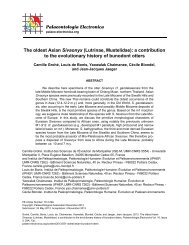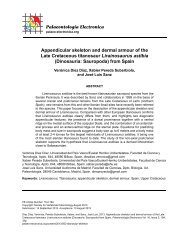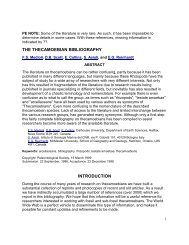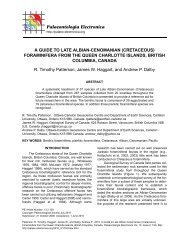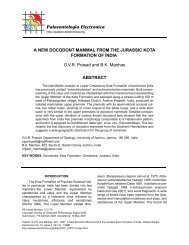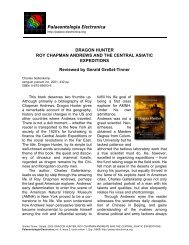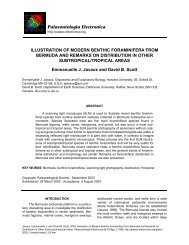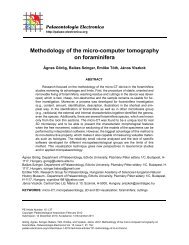Extraction of Calcareous Macrofossils from the Upper Cretaceous
Extraction of Calcareous Macrofossils from the Upper Cretaceous
Extraction of Calcareous Macrofossils from the Upper Cretaceous
You also want an ePaper? Increase the reach of your titles
YUMPU automatically turns print PDFs into web optimized ePapers that Google loves.
NIELSEN AND JAKOBSEN: FOSSILS IN HOT WATER<br />
waterblasting technique (Figure 6). The Wagner<br />
watergun proved suitable for cleaning <strong>the</strong> specimen,<br />
which can be referred to Typocidaris danica<br />
Ravn, 1928. According to Smith and Jeffery<br />
(2000), T. danica is a junior synonym for Temnocidaris<br />
(Stereocidaris) arnaudi (Lambert 1909).<br />
Maastrichtian bivalves <strong>from</strong><br />
Stevns Chalk Quarry, Zealand, Denmark<br />
The <strong>Upper</strong> Maastrichtian White Chalk is well<br />
exposed at <strong>the</strong> Stevns Chalk Quarry, which is adjacent<br />
to Stevns Klint. Calcitic shells <strong>of</strong> bivalves are<br />
commonly well preserved within <strong>the</strong> White Chalk.<br />
Shells <strong>of</strong> different species were carefully prepared<br />
by <strong>the</strong> use <strong>of</strong> small-scale wetblasting with carborundum<br />
powder (Paasche airbrush) (Figures 7, 8).<br />
To avoid damage <strong>of</strong> <strong>the</strong> shells during preparation,<br />
<strong>the</strong>ir inner surfaces were embedded in epoxy<br />
(“Strong Epoxy, Rapid,” product no. 2806, company<br />
Casco). The preparation, which took a few<br />
minutes for each shell, revealed subtle details <strong>of</strong><br />
external morphological features such as radial ribs<br />
and scales. Encrustations <strong>of</strong> bryozoan colonies<br />
were also preserved unaffected by <strong>the</strong> wetblasting<br />
(Figure 8.6-8.7).<br />
CONCLUSION<br />
The main advantages <strong>of</strong> <strong>the</strong> acid-hot water<br />
method are: 1) A significant reduction <strong>of</strong> time compared<br />
to <strong>the</strong> Glauber’s Salt method; 2) Large-sized<br />
samples can be treated, which makes it easier to<br />
extract fossils <strong>from</strong> bulk samples; 3) Fossils are<br />
cleaned <strong>of</strong> adhering sediment particles, which<br />
Figure 6. Medium-scale waterblasting<br />
and needle preparation <strong>of</strong><br />
a regular echinoid, Stereocidaris<br />
sp., <strong>from</strong> <strong>the</strong> Middle Danian Bryozoan<br />
Limestone (Tylocidaris abildgaardi<br />
Biozone) at Kulsti Rende,<br />
Stevns Klint. GM 2004.921. Scale<br />
bar 10 mm. 1. Before preparation.<br />
2-5. Successive stages in preparation.<br />
Figure 7. The Paasche airbrush, suitable for smallscale<br />
wetblasting.<br />
makes <strong>the</strong> method more reliable within a quantitative<br />
analysis <strong>of</strong> <strong>the</strong> sediments; 4) The method is<br />
particularly useful in examining drill cores, which<br />
have obvious sample size limitations; 5) The<br />
method has numerous applications in both <strong>the</strong> field<br />
and <strong>the</strong> laboratory in combination with waterblasting<br />
cleaning.<br />
ACKNOWLEDGEMENTS<br />
A. Dhondt (Bruxelles), E. Håkansson (Copenhagen)<br />
and J. Jagt (Maastricht) are thanked for<br />
<strong>the</strong>ir taxonomic analysis <strong>of</strong> <strong>the</strong> bivalves, bryozoans<br />
and <strong>the</strong> echinoid, respectively. M. Madsen (Copenhagen)<br />
kindly helped us during fieldwork. We are<br />
grateful to R.G. Bromley (Copenhagen), N.-M.<br />
Hanken, J.K. Nielsen (Tromsø) and two anonymous<br />
reviewers for <strong>the</strong>ir constructive comments.<br />
8



